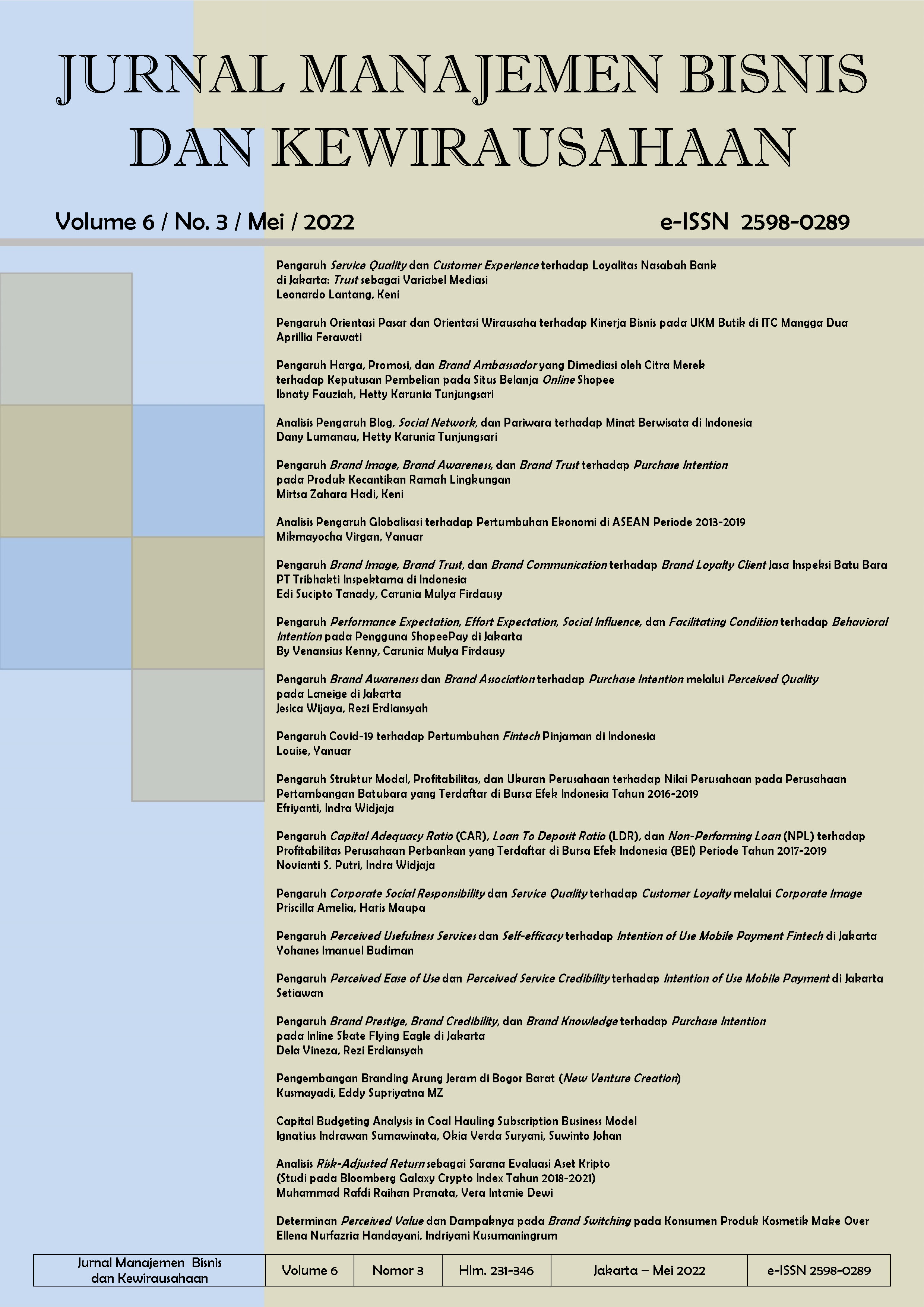Pengaruh Perceived Usefulness Services dan Self-efficacy terhadap Intention of Use Mobile Payment Fintech di Jakarta
Main Article Content
Abstract
This study was conducted to identify if there is any influence between the perceived usefulness of services and self-efficacy towards the intention of using mobile payment fintech in Jakarta. This study uses primary data sources, with the research instrument used being a questionnaire. The sampling method used is non-probability sampling with purposive sampling technique, where the researcher set specific criteria to be used as samples in the study, namely people who live in Jakarta and have worked and then also have a mobile payment application and have used it for transactions. The research sample in this study was 300 active users of mobile payment services in DKI Jakarta. The method of analysis and processing of data was obtained using the SmartPLS 3.2.9 software. This study gives the results that the impact of perceived usefulness services on the intention of use is significant and there is also a significant impact of self-efficacy on the intention of use. Where in the results of this study, self-efficacy has a higher significant value on the intention of using mobile payment.
Penelitian ini dilakukan untuk mengidentifikasi apakah ada pengaruh antara perceived usefulness services dan self-efficacy terhadap intention of use mobile payment fintech di Jakarta. Penelitian ini menggunakan sumber data primer, dengan instrumen penelitian yang digunakan yaitu kuesioner. Metode sampling yang digunakan adalah non-probability sampling dengan teknik purposive sampling, dimana peneliti menetapkan kriteria khusus untuk dijadikan sampel dalam penelitian yaitu masyarakat yang tinggal di Jakarta dan telah bekerja kemudian juga memiliki aplikasi mobile payment serta pernah menggunakannya untuk bertransaksi. Sampel penelitian dalam penelitian ini adalah 300 pengguna aktif layanan mobile payment di DKI Jakarta. Metode proses analisis dan pengolahan data yang diperoleh menggunakan software SmartPLS 3.2.9. Pada penelitian ini memberikan hasil bahwa dampak dari perceived usefulness services terhadap intention of use yang signifikan dan juga terdapat dampak yang signifikan dari self-efficacy terhadap intention of use. Dimana dalam hasil penelitian ini, self-efficacy memiliki nilai signifikasi yang lebih tinggi terhadap intention of use mobile payment.
Article Details
This work is licensed under a Jurnal Manajemen Bisnis dan Kewirausahaan Creative Commons Attribution-ShareAlike 4.0 International License.
References
Abdillah, L. A., Rofiq, A. A., & Indriani, D. E. (2020). Information technology utilization in environmentally friendly higher education. Proceedings of the Built Environment, Science and Technology International Conference (BEST ICON 2018), 350–355. https://doi.org/10.5220/0008908303500355
Alalwan, A. A., Rana, N. P., Dwivedi, Y. K., & Algharabat, R. (2017). Social media in marketing: A review and analysis of the existing literature. Telematics and Informatics, 34(7), 1177–1190. https://doi.org/10.1016/j.tele.2017.05.008
Arner, D. W., Barberis, J. N., & Buckley, R. P. (2015). The evolution of FinTech: A new post-crises paradigm. In University of Hong Kong Faculty of Law Research Paper (2015/047; University of Hong Kong Faculty of Law Research Paper, Vol. 47). https://hub.hku.hk/bitstream/10722/221450/1/Content.pdf
Bandura, A. (1991). Social cognitive theory of self-regulation. Organizational Behavior and Human Decision Processes, 50(2), 248–287. https://doi.org/10.1016/0749-5978(91)90022-L
Compeau, D. R., & Higgins, C. A. (1995). Computer self-efficacy: Development of a measure and initial test. MIS Quarterly: Management Information Systems, 19(2), 189–210. https://doi.org/10.2307/249688
Davis, F. D. (1989). Perceived usefulness, perceived ease of use, and user acceptance of information technology. MIS Quarterly: Management Information Systems, 13(3), 319–339. https://doi.org/10.2307/249008
Fishbein, M., & Ajzen, I. (1975). Belief, attitude, intention and behavior: An introduction to theory and research. Addison-Wesley.
Kalinic, Z., Marinkovic, V., Molinillo, S., & Liébana-Cabanillas, F. (2019). A multi-analytical approach to peer-to-peer mobile payment acceptance prediction. Journal of Retailing and Consumer Services, 49, 143–153. https://doi.org/10.1016/j.jretconser.2019.03.016
Phonthanukitithaworn, C., Sellitto, C., & Fong, M. W. L. (2016). An investigation of mobile payment (m-payment) services in Thailand. Asia-Pacific Journal of Business Administration, 8(1), 37–54. https://doi.org/10.1108/APJBA-10-2014-0119
PwC. (2019). It’s time for a consumer-centered metric: Introducing “return on experience.” https://www.pwc.com/cl/es/publicaciones/assets/2019/report.pdf
Stewart, H., & Jürjens, J. (2018). Data security and consumer trust in FinTech innovation in Germany. Information and Computer Security, 26(1), 109–128. https://doi.org/10.1108/ICS-06-2017-0039
Susanto, A., Chang, Y., & Ha, Y. (2016). Determinants of continuance intention to use the smartphone banking services: An extension to the expectation-confirmation model. Industrial Management and Data Systems, 116(3), 508–525. https://doi.org/10.1108/IMDS-05-2015-0195
Wang, G., Putri, N. M., Christianto, A., & Danny Hutama, W. (2019). An empirical examination of characteristics of mobile payment users in Indonesia. Journal of Theoretical and Applied Information Technology, 97(1), 169–182. http://www.jatit.org/volumes/Vol97No1/15Vol97No1.pdf
Wang, Y. S., Lin, H. H., & Luarn, P. (2006). Predicting consumer intention to use mobile service. Information Systems Journal, 16(2), 157–179. https://doi.org/10.1111/j.1365-2575.2006.00213.x
Yadav, R., Chauhan, V., & Pathak, G. S. (2015). Intention to adopt internet banking in an emerging economy: A perspective of Indian youth. International Journal of Bank Marketing, 33(4), 530–544. https://doi.org/10.1108/IJBM-06-2014-0075


